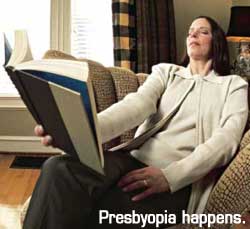Amblyopia ("Lazy Eye")
 Amblyopia or "lazy eye" occurs when one eye develops differently than the other, causing it to see less well than the other. In order for a child's visual system to develop normally, each eye has to be used and seeing clearly. Sometimes a difference in focusing ability causes one eye to be used more often. Other times, the eyes are misaligned ("crossed eyes" or strabismus), causing one eye to "shut off" to avoid double vision.
Amblyopia or "lazy eye" occurs when one eye develops differently than the other, causing it to see less well than the other. In order for a child's visual system to develop normally, each eye has to be used and seeing clearly. Sometimes a difference in focusing ability causes one eye to be used more often. Other times, the eyes are misaligned ("crossed eyes" or strabismus), causing one eye to "shut off" to avoid double vision.
SYMPTOMS AND RISK FACTORS
Amblyopia is often difficult to detect in children. Some possible symptoms and signs:
- A child may noticeably favor one eye over the other by covering one eye, tilting or turning their head when watching TV, reading, or doing any activities.
- A child may have trouble seeing things on one side, frequently bumping into things.
- You may notice that your child's eyes are not aligned, whether it is constant or on occasion.
Children who were born prematurely, who have had serious illnesses, or have a family history of lazy eye may be at risk for vision problems that can lead to amblyopia. The best way to tell if your child has any vision problems is through a complete eye exam from as early as age six months to three years. Early detection and treatment is critical to prevent any long term functional vision loss.
TREATMENT
Ambylopia often can't be entirely corrected. The amblyopic eye will always be a bit weaker than the other. However, with treatment, vision in the amblyopic eye can be improved and optimized. Treatment involves encouraging the weak eye to develop. This is done through the use of eye patches, vision therapy, glasses, and/or surgery to correct a misalignment. The stronger eye may be patched to encourage the weak eye to develop. Vision therapy can help to correct any improper use of the eyes and to train the two eyes to work together better. Glasses will often be needed to correct any blur or focussing problems. Depending on the type and size of the eye turn or misalignment, surgery may be needed to correct it.
Astigmatism
 The cornea is the transparent front layer of the eye and it is responsible for much of the eye's focussing power. If the cornea is irregularly shaped, it can cause the eye to focus images incorrectly on different parts of the retina. This is known as astigmatism and it is a type of distortion. For the cornea to focus images correctly, it should be round in shape, like a basketball. Astigmatic corneas are shaped more like a football. This causes a distorted view when looking at objects far and near.
The cornea is the transparent front layer of the eye and it is responsible for much of the eye's focussing power. If the cornea is irregularly shaped, it can cause the eye to focus images incorrectly on different parts of the retina. This is known as astigmatism and it is a type of distortion. For the cornea to focus images correctly, it should be round in shape, like a basketball. Astigmatic corneas are shaped more like a football. This causes a distorted view when looking at objects far and near.
We should remember that astigmatism is not an eye disease, but an eye condition which is fairly common and correctable with glasses and contact lenses. Astigmatism is often associated with myopia (nearsightedness) or hyperopia (farsightedness). It can be hereditary but it can also be caused by factors such as pressure on the cornea, incorrect posture, or increased use of the eyes for near work.
Strabismus ("Crossed Eyes")
 Strabismus or "crossed eyes" occurs when one or both eyes turns in, out, up or down. An imbalance in the control of the eye muscles usually causes crossed eyes. It often first appears before age 21 months but may develop as late as age six. For a child's vision to develop normally, each eye needs to be used and seeing clearly. Strabismus, if left uncorrected, can cause the vision in one eye to become weaker, a condition known as Amblyopia or lazy eye. This is why a comprehensive eye examination before age six months with a pediatric eye specialist is important and again at age three. It is a common misconception that a child will outgrow crossed eyes. This is simply not true.
Strabismus or "crossed eyes" occurs when one or both eyes turns in, out, up or down. An imbalance in the control of the eye muscles usually causes crossed eyes. It often first appears before age 21 months but may develop as late as age six. For a child's vision to develop normally, each eye needs to be used and seeing clearly. Strabismus, if left uncorrected, can cause the vision in one eye to become weaker, a condition known as Amblyopia or lazy eye. This is why a comprehensive eye examination before age six months with a pediatric eye specialist is important and again at age three. It is a common misconception that a child will outgrow crossed eyes. This is simply not true.
Treatment for Strabismus may include eyeglasses, eye patching, prisms, vision therapy, and in some cases, surgery. Glasses correct any focussing errors that exist. Patching encourages the use and development of the weaker eye. Prisms are special lenses that will artificially direct images onto the proper part of the retina. Vision therapy helps to correct the underlying cause of crossed-eyes by teaching better control of the eye muscles. Surgery may be needed to straighten the eyes, but unless eye muscle control is improved, the eyes may not remain straight. If detected and treated early, crossed eyes can often be corrected with excellent results.
Emmetropia
Emmetropia is the medical term for 20/20 vision without the need for glasses or contact lenses. It occurs when the optical power of the eye perfectly focuses an image on the retina. The opposite of emmetropia is ametropia. With ametropia, the eye focuses an image not on the retina but either too close, too far, or on different parts of the retina. These forms of ametropia, respectively, are commonly known as nearsightedness, farsightedness, and astigmatism.
Hyperopia (Farsightedness)
 Hyperopia is more commonly known as farsightedness. People who are farsighted see objects in the distance more clearly than objects which are closer. In hyperopia, the eyeball is shorter than normal and/or the cornea, which is the transparent front layer of the eye, is not curved enough. This prevents the eye from focusing images correctly on the retina.
Hyperopia is more commonly known as farsightedness. People who are farsighted see objects in the distance more clearly than objects which are closer. In hyperopia, the eyeball is shorter than normal and/or the cornea, which is the transparent front layer of the eye, is not curved enough. This prevents the eye from focusing images correctly on the retina.
A family history of farsightedness is a risk factor for developing hyperopia. Babies are often born farsighted but outgrow the condition as the eye develops into the correct shape. Hyperopia can also be a risk factor for developing certain types of glaucoma later in life.
Hyperopia can be corrected with eyeglasses or contact lenses. Laser eye surgery can also correct certain amounts of hyperopia.
Myopia (Nearsightedness)
 Myopia is the medical term for nearsightedness. It is a condition where objects up close are clearer than objects further away. The eyeball in myopia is longer than normal and/or the cornea is more curved than normal so images do not focus correctly on the retina. Myopia usually develops in early childhood though it sometimes develops in early adulthood. It can be a risk factor for more serious conditions such as retinal tears and detachments.
Myopia is the medical term for nearsightedness. It is a condition where objects up close are clearer than objects further away. The eyeball in myopia is longer than normal and/or the cornea is more curved than normal so images do not focus correctly on the retina. Myopia usually develops in early childhood though it sometimes develops in early adulthood. It can be a risk factor for more serious conditions such as retinal tears and detachments.
Myopia can have both a genetic and functional component. Children of nearsighted parents are at greater risk of developing nearsightedness. Fine detail close work, computer use, and reading can also cause myopia to develop.
Myopia can be corrected with eyeglasses or contact lenses. It can often be successfully corrected with LASIK or other types of refractive eye surgery. Much research is being done on how to slow down the progression of myopia in children. Therapy for this consists of the use of special rigid contact lenses worn overnight, bifocal soft contact lenses, or the use of medicated eye drops.
Presbyopia
 Presbyopia is a natural part of the aging process. As we get older, normal changes to the lens in our eyes and the muscles that control its shape cause us to lose our ability to focus up close. It usually starts in your 40's and progresses through your 50's and 60's. Needing to hold reading material farther away or needing more light to read are typical symptoms. Increase fatigue with reading and computer work are other signs. Bifocals, progressive lenses, and reading glasses are the most common ways to remedy this condition. Multifocal or monovision contact lenses are also available to correct presbyopia.
Presbyopia is a natural part of the aging process. As we get older, normal changes to the lens in our eyes and the muscles that control its shape cause us to lose our ability to focus up close. It usually starts in your 40's and progresses through your 50's and 60's. Needing to hold reading material farther away or needing more light to read are typical symptoms. Increase fatigue with reading and computer work are other signs. Bifocals, progressive lenses, and reading glasses are the most common ways to remedy this condition. Multifocal or monovision contact lenses are also available to correct presbyopia.
There is no cure for presbyopia and currently no consistently successful treatment with laser surgery, although much research is being done to find surgical solutions for presbyopia.
